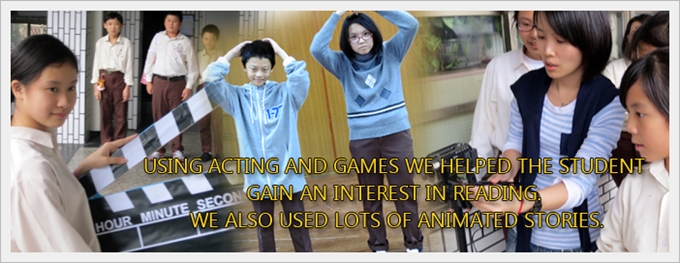| |
 The Small Small Bookshop has awaken the joy of reading within the community throu gh reading activites. So how should the Yu-Tsai Bookworms awake a thirst for reading within their fellow students? gh reading activites. So how should the Yu-Tsai Bookworms awake a thirst for reading within their fellow students?
Small Small has held a large number of parent-child reading events. Adults can bring children along to participate and we wanted to do something similar. Therefore, in December the Yu-Tsai Bookworms held 5 peer assisted reading events for the lower grade students. The older students read stories to the younger students. Using acting and games we helped the student gain an interest in reading. We also used lots of animated stories.
Peer-assisted Reading Plan
Date: December, every Friday from 4:40-5:30. 5 times in total
Particpants: Students from grades 1 and 2
Purpose: To create an interest in reading through diverse stories.
Book Choice: A book about gender equality and a book about self-identity
Story Telling Process: Brainstorm – First book, guided reading combined with illustrations – Film about gender equality – Exploring the topic – Second book, guided reading combined with illustrations – Sharing
Training for Story Telling I - Illustrated Picture Books, Sounds and Expressions
How do you read a book to make interesting? It’s best to let the teachers and children join in in the story and to let the characters come alive!

Selecting Picture Books
What kind of concept do we want to give the lower grade students? Self-identity and gender equality both seem like good ideas so we chose books about both topics. |
Portrait
In the story about self-identity, we replaced the characters of the story so it was closer to the life of the students and teacher. We used our time after school to explain the activity to the teachers and to take pictures. |
Processing the Images for the Picture Books
Before making the picture books, we had to scan the two books into the computer and then cut them down to the correct size so that we could use Photoimpact to add the images of the teachers and students that we shot earlier. We then erased the text in the pictures and then saved the characters and backgrounds seperately. |
Making the Presentation
After getting everything ready, we used Powerpoint to make a presentation. We put each character and background onto each of the pages. Then we entered the writing using bopomofo. At last, we added some animation to make the story come alive. |
The Hardest Part of Story Telling – Expressive Voice
After making the picture books, mastering telling a story seemed so much more difficult. This test whether or not the people making the presentation and the people telling the story could work well together. We continuously practiced so that everyone understood what they were doing and the tone of the storytellers was correct. The hardest part was training to have an expressive voice and the story tellers had to work very hard. |
 Bookworm Says: Bookworm Says:
The story and characters had automated effects and could move which really made the story interesting!
Using PowerPoint to make the animated book really was amazing!
Training for Story Telling II - Making an Animation Using Real People
To help the students better understand gender equality after hearing the story, we made another animation with a similar theme.

Script Design
The first step to making a film of course is to write a script and decide on a topic!
To connect with the book’s theme of gender equality we gave the film a similar name to that of the original book. After getting a name, everyone started to think about how to use the idea that ‘boys can also do the things that girls typically do’ for the plot such as play with dolls, read comics for teenage girls, etc. |
Rehearsal
After everyone animatedly discuss and decided upon a script. Then we chose characters and began rehearsals and the three boys were of course the main stars. Apart from practicing lines, rehearsals mean practicing walking with the cameras to the correct places. |
Filming
Action!It was our first time to make a film and we had trouble looking at the camera and we couldn’t stop laughing! Retake after retake, we all became more comfortable and made faster progress. |
Editing and Soundtrack
After filming, we used PowerDirector to edit and add the soundtrack. It turns out that using these clips to make a film really isn’t that easy! The time was tight and getting the writing and music right was very important.! |
Narrating
The film was finally finished! Even though it’s a film, we still wanted to tell the story and so the speaking part was to be done live rather than added to the film. The lines in the film are another kind of skill. The voice and expression needed to be good so that everyone listening would be involved in the film! |
 Bookworm Says: Bookworm Says:
In making the film, we had to put aside our modesty and risk everything in order to be successful!

Source : Yu-Tsai Bookworms / Book : Me, Mademoiselle Zazie a-t-elle un zizi? |
|